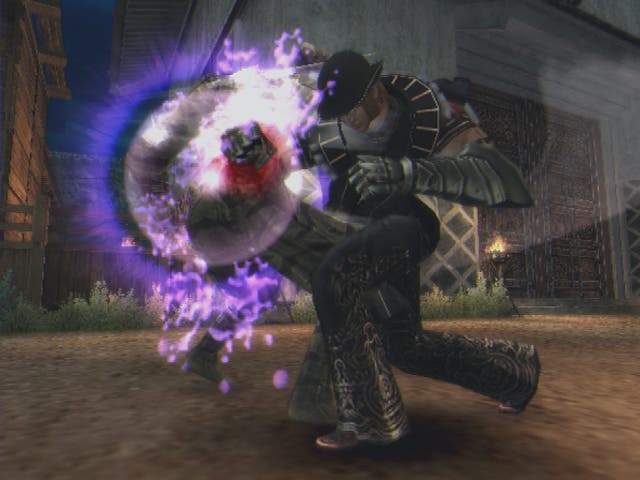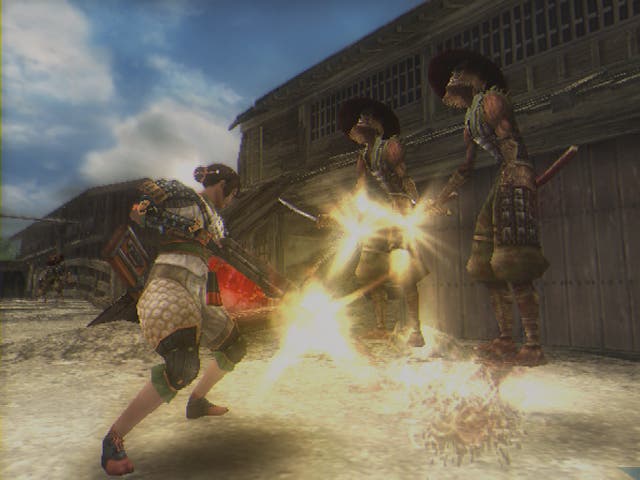Onimusha: Dawn of Dreams
It's a whole new franchise, sort of.
So much for the whole Onimusha trilogy thing, then. Less than a year after the third and supposedly final instalment in the series hit European shores, Capcom announced that another Onimusha game was on the way - but don't make the mistake of assuming it's a plain old sequel.
That's the advice of producer Yoshinori Ono, who's on hand to give us a sneak preview of Onimusha: Dawn of Dreams. He explains that Capcom just had to commit to a fourth game following billions of requests from fans, but they felt it was important to give the series a new twist: "We wanted to overhaul the gameplay and make a brand new game. So rather than just extending the Onimusha trilogy, we came up with a brand new Onimusha franchise."
That's why there's no number in the title, Ono says. "We didn't want to use [the name] Onimusha 4, because we've changed the game model completely and this is a new chapter... A new dawn."
He sums up the game by describing it as "a brand new action game with sim and RPG elements" that is designed to attract newcomers to the series, and to appeal to casual gamers as well as hardcore types. Ono says he agrees with comments made by series creator Keiji Inafune last year, who said that casual gamers are a dying breed in Japan - and that the focus needs shifting.
"Part of the reason for this is the fault of developers," says Ono, who reckons they just aren't producing the right kind of game to attract casual players.
"Obviously we have to appeal to hardcore gamers and middle-core gamers, but unless we recruit a new breed of users for the game, we're just going to fold up the industry altogether... So we thought we would use a big brand like Onimusha to [attract] a new breed of users as well."
Back to the future

Hence Dawn of Dreams' array of new gameplay elements, along with a brand new set of characters and plotline. But long time Onimusha fans needn't worry - there are still plenty of treats in store for you.
"There are lots of links to the previous games in the Onimusha series. Some of the secrets that were not revealed in Onimusha 1, 2 and 3 may be revealed in this title... Each character has some sort of relationship with the other Onimusha games."
The characters are key to the major gameplay changes introduced in Dawn of Dreams. There are five playable fighters in total, and they can pair up thanks to the new "Allies System", which allows you to switch control at any time by pressing the L2 button.
In addition, you can use the D-pad to give your ally orders when you're not directly controlling them, such as "Follow", "Attack" and so on. Plus you can tell your ally to absorb souls while you're busy fighting, and this is useful in a variety of ways - there's an invisible enemy in some levels, for example, who becomes visible if enough souls are absorbed.
Or, for example, if you're busy taking on a boss you can tell your ally to keep the door closed so back-up baddies can't come in and help him out. Ono says that this strategy should prove very useful for those who aren't very good at games generally.
History lesson

Not all of the characters in Dawn of Dreams are boring old samurai, Ono explains; they all have different weapons and skillsets. That said, the first fighter Ono introduces us to, Soki, is indeed a samurai. Like many of the characters in DoD, he's based on a real historical figure - Ono says it is his personal ambition to introduce Japanese history to the game.
Soki is very much a traditional hack and slasher - there's no timing your critical attacks perfectly here, he likes to jump in with all swords blazing. Special moves include the Head Splitter, a powerful vertical slash that does just what it says on the tin, and the Blade Jab, which can reach enemies that are a little further away. There's also a 360-degree Whirlwind move and something called the Sword of Purification, where Soki's sword will do all the work for him, "slaying enemies for purification as if it had its own will."
Then there's Jubei, who's the granddaughter of the main character in Onimusha 2 and the only member of the Yagyu clan to possess Onimusha blood. She's a ninja, and therefore as swift and nimble as you might expect. Special moves include Flurry, a jumping attack called Rising Dragon which is effective against airborne enemies, and Moon Blade, where Jubei will lob small knives about the place.
Next up is Ohatsu, who's naughty Nobunaga's niece. So how come she's on the right side? Well, that will all be explained in the game, Ono says. Ohatsu specialises in firearms - her Charge-up move shoots out superpowered bullets, Lift can fire enemies into the air and Gunpowder will unleash a series of small explosions.
Representing Europe is Roberto, the son of a Japanese lady and a Spanish missionary. (Spain was one of only two countries allowed to trade with Japan in the 16th century, history fans.) He prefers close combat with his fists and feet, and special moves include a harcore Nova punch and a flurry attack called Hook Storm. According to Ono, designers who worked on Capcom beat-'em-ups such as Street Fighter have been drafted in to ensure the combat system works perfectly.
And finally there's Tenkai, who may or may not be the reincarnation of Samonosuke - you'll have to play the game to find out. He's a monk, and uses his monk's staff to pull off moves such as the Frenzy Drill and Thunderclap, which downs enemies with bolts of lightning. Tenkai can also use magic - for example, he can transform soul orbs into bombs, and place a magical sticker on enemies which forces them to become his allies.
Ally pally

The Allies System will obviously come in handy since different characters' skills are suited to different combat situations. But that's not all - once you've made an ally, you can return to areas you've already visited and get them to help you out with stuff you weren't able to do.
For example, Jubei, being a very petite 14 year old ninja, is ace at crawling through tiny little holes that are too small for the bigger types. Tenkai can talk to dead spirits and obtain useful items from them, while Ohatsu, like Jacques in Onimusha 3, can shoot out a special wire which enables her to fly over short distances and reach high up places. And as for Roberto, his extreme physical prowess is useful for bashing up rocks and breaking down doors.
But while the Allies System is clearly the most important new feature of Dawn of Dreams, it's certainly not the only one. Say hello to the new "Test of Valour" mode, which gives you some useful training and lets you test out new skills, weapons and so on.
You can try your hand at the various Tests of Valour as many times as you like, and you'll be awarded either a bronze, silver or gold medal if you do well. Get enough gold and you'll unlock new weapons and the like.
Indeed, there are more weapons than ever in Onimusha 4 - "around 20 per character" - and each one can be customised in different ways. Armour can also be customised, and as in Onimusha 2, you can use the money you've collected from defeated enemies to buy new skills and items.
Puzzle problems

Another new feature comes in the form of a change to the puzzle system. Ono reveals that he didn't think much of the puzzles in the previous game, and in fact begged the producer to abandon them all together. But now he's the producer, of course, he can do what he likes.
And what he likes is the "Appraise System", which means that if you're totally stuck on a puzzle, you can "break" it to unlock the item you'd have won for finding the solution. However, you'll have to pay a pretty price to own said item, and you won't know what it is till you've handed over the cash - so while you might get a wicked new sword, it could just be boring old herb. There are loads of items to collect as you progress through the game, and around 100 of them can be combined to create new objects.
It all sounds like fun, but how long will the fun last? Well, Ono believes that the play time for Onimusha 3 was "quite short", and he says that they've learned their lesson. He reckons Dawn of Dreams, which comes on two discs, should take between 30 to 40 hours to complete - although one Capcom playtester has set a record of 16 hours.
You can also expect two and a half hours' worth of cut-scenes, all of which are just as impressive as those in previous games - if not more so, judging from what we've seen so far. Ono is keen to point out that it's about playability just as much as good looks, though: "The action is very smooth, it's not just pretty graphics."
West meets East

All in all, Dawn of Dreams appears to be coming together very nicely, which is of course good news for Onimusha fans - many of which are of the European variety, despite the series' strong Japanese flavour. So why do we like it so much?
"I would like to ask you that question!" Ono says with a chuckle.
"Maybe the mysterious part of it may be appealing to gamers. I don't know, but sometimes I think European gamers reckon everyone in Japan's walking around wearing kimonos. And you've got Memoirs of a Geisha on now and that's a tiny part of Japan, that's not happening all over, you know..."
Ono goes on to say that Capcom thought Shadow of Rome would appeal to us Westerners because it's set in Europe, "But unfortunately that was not the case. The Japanese were not particularly interested in the Roman empire either, so Shadow of Rome didn't do very well."
So, do Japanese people think we all go around wearing togas and fighting lions then? "You never know, especially with gamers!" laughs Ono.
Our time's almost up, so let's finish by asking Ono what he thinks is the future of the Onimusha series - surely, if this is a whole new franchise, another game is in the works?
"Well, first of all we're very keen on seeing the response from gamers," Ono says.
"You know, obviously while creating the game we had to think ahead. We created this game a stepping stone to a possible new generation." The key, Ono reiterates, lies in the new Allies System and the option to combine items - "If you go on Xbox Live, you may be able to trade items and so on."
Does that mean Onimusha Xbox 360 could be on the way? "Anything's possible," Ono reckons - and that means we could see a handheld Onimusha game, too.
"That is quite possible, especially since in this title we've got five different characters, so different people could play as different characters and so on." He refers to Mario Kart DS and the way you can play against people from all over the world, stating: "Ideas are there, but we haven't got anything in the pipeline yet." Here's hoping...


